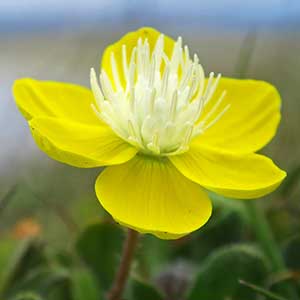Platystemon californicus
Platystemon
cream cups
cream cups
leafy, erect to decumbent, branching distally.
10-90 × 1.7-8.1 mm;
blade broadly linear;
margins entire;
apex rounded to long-acute.
mostly opposite or whorled, sessile;
blade broadly linear, unlobed.
peduncle 3.4-25.8 cm;
bud globose to ovoid-cylindric.
axillary or terminal, 1-flowerd;
bracts absent;
bud nodding.
petals white to cream colored, sometimes with yellow tip and/or base, rarely gold overall, sometimes tinged red in age, narrowly ovate to obovate, 6-19 × 3.5-16 mm, apex acute to rounded;
ovary cylindric to oblong-ellipsoid;
stigmas linear, margin revolute.
receptacle slightly expanded beneath calyx;
sepals 3, with overlapping, loosely connivent flaps;
petals 6, occasionally more on robust specimens;
stamens many in several series;
filaments dilated distally;
pistil 6-many-carpellate;
ovary with each carpel forming almost closed locule with 4-24 ovules;
stigmas 1 per carpel.
ellipsoid, to 1.6 cm.
erect or sometimes nodding, carpels dissociating, each torulose and breaking transversely into 1-seeded segments, sometimes also releasing free seeds.
black, shining, smooth.
usually many, aril absent.
= 6.
= 12 (plus occasional supernumerary chromosomes).
Platystemon californicus
Platystemon
This highly variable, wind-pollinated taxon has been split into as many as 57 species on the basis of characteristics showing little cohesiveness. Ecotypic variation has produced morphologic extremes ranging from semisucculent, nearly glabrous coastal forms to very robust, moderately pubescent plants of interior grassland to compact, densely pubescent plants of semidesert habitats (G. L. Hannan 1979, 1982). Several varieties are recognized in some currently used floras: Platystemon californicus var. ciliatus Dunkle, from Santa Barbara Island; P. californicus var. nutans M. Brandegee, from coastal San Diego County and Santa Rosa and Santa Cruz islands; and P. californicus var. ornithopus (Greene) Munz, from San Miguel, San Nicholas, and Santa Rosa islands. These geographically restricted morphotypes appear to result from the same sort of ecotypic variation found in many other parts of the range. Rather than naming each ecotype, it seems best to treat Platystemon as a single, highly variable species with many locally adapted, intergrading populations.
(Discussion copyrighted by Flora of North America; reprinted with permission.)
Species 1 (1 in the flora).
(Discussion copyrighted by Flora of North America; reprinted with permission.)


